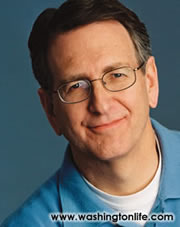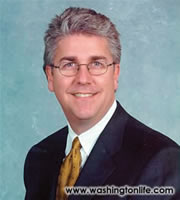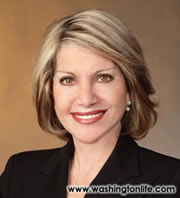Follow the boomer
|
||||||||||||||||
 |
Mark Bisnow Moderator Mark Bisnow has been a lawyer, politico, and businessman in Washington for nearly three decades and publishes a growing series of electronic newsletters, including Real Estate Weekly, which features interviews with top Washington- area experts. He also writes“BizKnow,” a weekly personality column in the Washington Business Journal. |
 |
Casey Margenau With more than 25 years in sales, over a decade as a “Top Producer” in Northern Virginia, and Re/Max’s “Number One Agent Worldwide” for five consecutive years. Casey Margenau uses his wealth of experience to ensure the financial success of his clients. His professionalism and attention to detail have led him to the very top of his field. “As the market gets hot, people raise their prices. We have raised them beyond the level of reality, so now the market is correcting and prices are coming back in line. Right now we have more inventory than demand.” |
 |
Jim Bell Jim Bell recently joined Sotheby’s Washington Fine Properties and specializes in the sale of Washington, D.C., properties—primarily in the Kalorama, Georgetown, Dupont Circle and greater Northwest neighborhoods. With real estate sales of over $100 million, Jim has been a consistent sales leader. “With the baby boomers you also have an architectural element—they prefer large apartment buildings downtown or Logan Circle to townhouses unless they have an elevator.” |
 |
Jane Fairweather Jane Fairweather has been named the“Number One Coldwell Banker” agent in the Washington Metropolitan Area for the last six years and has consistently ranked among the top ten Coldwell Banker agents in the nation since 1998. In 2004, she made $100 million in sales, primarily in Bethesda, Potomac and Chevy Chase, Maryland. “According to the last Census report baby boomers represent 52 percent of our market in the Washington metropolitan area. The last baby boomer will turn 55 in 2020. What do boomers want to buy? They want to buy downtown locations, water properties, golf communities—any kind of a second home market. Follow the boomer and you will make money.” |
Mark Bisnow: Which region is the hottest: Northern
Virginia, Maryland or Washington?
Casey Margeneau: I guess it depends on what
price range you’re talking about and what type
of product. I don’t know what’s going on in
Maryland or Washington as much as I know the
nuances of my marketplace in Virginia, which is
doing very well, but we’re loaded with inventory.
There is great supply and demand, but demand is
cautious because most of the inventory is priced
a little too high.
MB: And why is that?
CM: Because of the natural way the market
works. As the market gets hot, people raise their
prices. We have raised them beyond the level
of reality, so now the market is correcting and
prices are coming back in line. Right now we
have more inventory than demand.
Jim Bell: In D.C., every price range is selling well.
But the higher the price range, the better the
value of property.
MB: At what price do you start to see good values?
JB: Anything above $2 million.
MB: I thought the economy in Virginia came roaring
back after 2001. Maybe there are less internet companies
than before, but there are always government
contractors. Why isn’t there a ton of money sloshing
around to buy a $2 million- plus home?
JB: Five years ago a $2 million home did not
sell at all. The fact that we are selling $2 million
homes like they were $500,000 and $600,000
dollar homes eight or nine years ago is phenomenal.
There are a lot of sales. The opposite could
be asked: how do we have so many people who
can afford expensive homes and so fast?
Jane Fairweather: In our market in Maryland,
a “move-up” home is probably $1 million
to $1.6 million. That’s not an upper-bracket
luxury home. A glamorous home, in a glamorous
neighborhood will cost you at least $2
million.
MB: What neighborhoods are you talking about?
JF: All the neighborhoods close-in—Bethesda,
Chevy Chase, Edgemore, Greenwich Forest…
MB: How much less house do you get close-in versus
further away in Potomac? Suppose you had $2 or
$3 million dollars. What is the difference between
Potomac and Chevy Chase?
JF: The first thing you give up is land. When
you’re out in Potomac, you get two to three
acres, three-car garages and nine bedrooms with
9,000 to12,000 square feet. Closer into the city
you’ll probably get 5,000 square feet for pretty
much the same price as what you sold your
house for in Potomac.
MB: Is Potomac dying?
JF: No, but there are a lot of empty-nesters
whose children have grown up and who are
looking to move out of the suburbs. There are
78 million baby boomers in the U.S. and the
first wave, the Vietnam generation, are in their
fifties. They are asking themselves, “Why do I
need to live in the suburbs? I’d like to be where
the action is.” The action is in all the downtown
locations. It is what spurred the development of
high-end stuff in Friendship Heights and it is
causing developers to build town centers in suburban
locations.
MB: But, are there people taking the place of the
generation that’s leaving Potomac?
JF
: There are plenty of people who still want a
big house.
JB: With the baby boomers you also have an
architectural element—they prefer large apartment
buildings downtown or Logan Circle to
townhouses unless they have an elevator. They’re
looking forward 10 to 15 years in their lives. They
are also interested in getting second homes and
they typically want those to be one-level too.
MB: Are you seeing greater interest in living closer
because of higher energy/gasoline costs?
JB: They would rather not commute because
of time, not necessarily because of higher prices
of gasoline.
JF: In the price range we deal with, gasoline is
not an issue. We are talking about the middleto-
upper end of the market. When you are
time-pressed, the time you spend in your car
commuting back and forth is time you miss
living your life.
MB: But for years there has been terrible congestion.
Is it that much worse now, that people are changing
their ways?
JF: No, what I think you have is this emergence
of baby boomers.
MB: What about families who have young children?
Do they want to be in D.C.?
JB: They are staying.
MB: Why don’t they want to move to green spaces?
JB: Quality of life. Their friendships are here.
The parks have been renovated. The stores are
here. The core of everything you used to go to
the suburbs for is now in the city. It is not a
Washington phenomenon. You see it in all the
urban centers along the East Coast and Chicago.
People are in the urban areas.
CM: It is always interesting to see how the
market has changed. People moved out into
big lots at one point, now they want to move
to tiny lots. Recently I went to an Economics
Summit, where I learned that, seven years from
now, we will be 480,000 units [short on] inventory.
We have 80,000 new jobs in Northern Virginia
alone right now. There is always a group of
people moving in and moving out of Washington.
Fairfax County has the highest per capita
income in the country and we’re about seventh
or eighth in housing prices—not so bad. The
housing is expensive but it is affordable in comparison
to incomes.
JF: I think something else contributed to the
downtown Washington phenomenon. Typically,
young people rented. But with low interest
rates they were suddenly able to buy. Instead
of putting up rental buildings, developers are
putting up condos. That makes a stable neighborhood
and the retail follows because you have
owners who are not moving every two years.
JB: If you think about it, an entry-level associate
at a law firm is making six figures. A new
class comes in every September who can afford
a $450,000 property no money down. And that
is a nice condominium for anywhere you want
to buy—Bethesda, Arlington, downtown Washington.
But it is the income group that we are
dealing with in Washington, inside the Beltway.
The incomes are driving the amenities, type of
housing being built and the quality of life that
is being established here. And yes, [Mayor] Tony
Williams has helped immensely, but it is just
beyond that. It is a shift in population. The population
shifted outside the city in the 1960’s and
now they are coming back.
CM: In [Northern Virginia], the condominium
market has just died. Until recently, condominiums
had a phenomenal investment. Normally
we would have 800 condominiums on the
market in Arlington and Alexandria. Currently
we have 1,800 to 2,000 condominiums on the
market. None of them are selling. We have over
60 percent ownership by investors.
JF: It’s a totally different market than Chevy
Chase.
CM: North Arlington is doing fine because
you have the urban center, but still they are not
selling as well as they have been.
JB: Everybody just jumped in and overbuilt
the condominium market. You do not necessarily
want to buy a condominium in suburbia
because it will create more suburbia. But in an
urban center where there are boundaries—as
there are in Bethesda, or for Arlington or Reston
Town Center…
CM: Reston’s dead!
JB: Well, boundaries create value.
JF: Because there is a limited supply. There is
only so much land for building in downtown Bethesda. For every unit that is for sale, I have
30 buyers! They are lined up because there are
no units. If you suddenly put 30 units on the
market for every one buyer, soon there will be
no demand.
MB: But the story about Reston does not worry you?
Reston is not that far beyond McLean. You could
have North Bethesda or Rockville suddenly creating
luxurious new developments.
JF: They are! They are developed In downtown
Bethesda, no builder will be come into
that market and be able to build for less than
800 dollars per square foot and if you are going
to get prices like that, you have to offer a downtown
living experience, not suburban projects.
An
y developer that comes into town to do suburban
condominiums might as well declare
bankruptcy before he digs a hole because it’s not
going to sell. Create your downtown first and
then your buyers will follow.
CM: I have no concern about the single family
houses and luxury homes. The upper end of the
market is doing extremely well, so if you’re in
Fairfax County in a $1million plus home, you
have made a very safe investment. I’m scared
of investing in these subdivisions that developers
are building in Loudon County and Prince
Georges County where houses are being sold
for $1.5 million. We have done too much with
the condominium market, the biggest problem
is that they were bought by investors and now
we have nine condos a week coming on the
market with no sales. All of these investors paid
$250,000 to $350,000 dollars for a condo and
now they are trying to make $200,000, with no
added value.
JF: In my market, the developers are hip to that.
Buyers don’t want to live with investors. They
won’t let you sell it for two years, and they won’t
let you rent it for one year. To protect the home
owner, they do not want investors
JB: Absolutely. You have to hold it for two years
and, affidavit after affidavit, you have to say you
are an owner occupant. They will not let investors
buy.
MB: What if interest rates spike up?
JB: I have been in the banking business before as
head of First Union’s Morris Division in Washington.
I started when interest rates were 14 to
16 percent for adjustable mortgages, so a good
interest rate is 8 percent for me. At this level,
you look at the debt ratio of the people in this
market and they do not carry debt. If they have
debt at all, it’s student loans.
CM: The Virginia market is the same we are not
dealing with very much debt. We are dealing
with move-up buyers. They have at least 500,000
dollars equity in their property. They are not
overextending on their purchase. Interest rates
are a short term factor because anytime there
is indecision in the market, people make short
term decisions to hold off, which has been happening
since April of this year. There has been so
much talk about the bubble but this is a shortterm
slow down in the market and it is actually
healthy for prices to come in-line, and gets
us out of the crazy bidding wars, allowing the
market to breath so that it can move forward
again .
JF: In my market, interest rates will not matter.
I’m talking about people who are downsizing
and expecting to live there for 20 years or
looking to buy a move up house. Fall markets
always have fewer buyers and more sellers..
JB: I agree to a certain extent. I do not think
they are desperate, but if they do not make a
deal now, there are six other people right behind
who will.
MB: Predictions for a year from now? Are we going
to be sitting here talking about another 20 percent
appreciation?
JB: I think there’s going to be a healthy seven
to ten percent growth. There is a strong, healthy
market here, and you have a lot of well qualified
buyers who have a lot of cash.
MB: You do not think it is going to stop?
JB: It has stopped in other markets already.
People forget what happened after September
11? You couldn’t give away an $800,000 house
in Washington D.C. for a year. Take Columbia
Heights for example. You have a lot of people
who bought $350,000 condos and wanted
to sell them for $450,000, but you can buy a
house for $355,000. It makes no sense. That is
a clear example of a housing imbalance. Where
you have good housing stock at a fair market
price, you will have willing buyers. That is what
makes this market very healthy.
MB: What is the price per-square-foot in your
various markets?
JB: The price per square foot in Georgetown
is $753 but a luxury condominium in Georgetown
is about $1,000. In Kalorama, it is around
the $650 to $700 market, and depending on
renovation it can go as high as $750. Georgetown
is about 20 to 25 percent more expensive
than Kalorama. Logan Circle is comparable
to Georgetown and Kalorama. The condo price
per square foot could be as high as $700 to $900,
and Capitol Hill is getting up there, too.
CM: I have a different market them what is going
on downtown. I don’t see that much appreciation
next year, maybe four to six percent. There
is a possibility that we might get a bump because
of the construction costs, because of Katrina. I
also believe that the big builders are going to
divert resources. Right now they artificially keep
up their supply and demand by only allowing so
many houses to be sold per month because they
don’t want to get too far out and they don’t have
the production capacity to build any more.
Because the developers are national, houses
are built in factories, and are shipped and
assembled on site. I think they are going to take
some of that capacity away from those projects
and use that to deal with Katrina rebuilding. The
effect may be a bigger housing shortage, but I
also see that there is an affordability problem. When our average price of a home is over
$550,000 and the mean is over $600,000 in
Fairfax County, some people find it very difficult
to afford housing. Even though I work on the
luxury end of the market place, it still all trickles
up. Long term, we’re going to go up. Short term,
I don’t know if we’re going to have as great as
an appreciation as we have had over the past
few years.
MB: And what about square footage?
CM: We’re at $250 to $300 a square foot for
houses and $500 per square foot for luxury
homes. That is construction price, not
including land. The lots are going anywhere
from $500,000 on the low end to over $1
million.
JF: My market is different because we operate
in scarcity of single family homes. Chevy
Chase has a building moratorium that is going
to further tighten the supply. Builders are not
going to want to go in there and take the
risk of knocking a house down and putting
up a big house. The few houses that do come
on in the market are going to continue to
appreciate because there is no place to go.
In the last three years, the price per square
foot for land has gone from $315 to $750
to $800 in prime locations. If you want to
buy something in Edgemoore you are at $2
million, and that’s a tear down. In terms of
the condo market, unlike Northern Virginia,
we are under built to an extreme. The Adagio,
in downtown Bethesda, came on the market
with 90 units and sold out in two weeks with
a waiting list of 3,000 people. According to
the last Census report baby boomers represent
52 percent of our market in the Washington
metropolitan area. The last baby boomer will
turn 55 in 2020. What do boomers want to
buy? They want to buy downtown locations,
water properties, golf communities—any kind
of a second home market. Follow the boomer
and you will make money.
